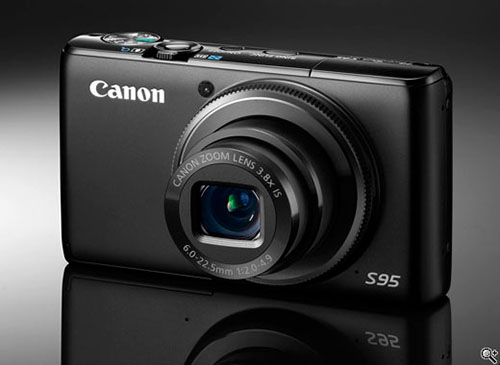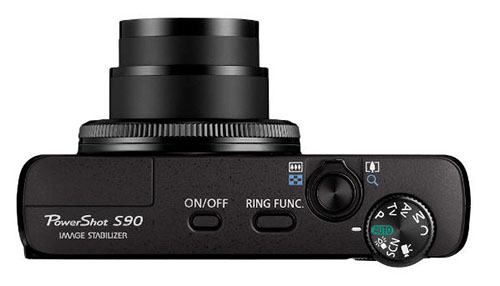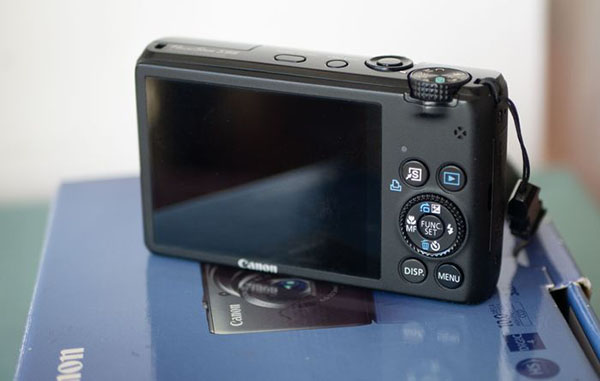It is not a wonder that Canon Digital camera scores 97% in the Which? Reliability test amongst its competitors. Reliability is built over a period of time; by making the product that really make sense to the buyer’s purpose, and also assuring a good return on investment. Product development has different facet to it; the major one is to understand the customer requirement.
Canon has a line up of digital cameras boxed under each category. The PowerShot S series defines compactness, point and shoot option. Once after the S30 series, the development is reared on prosumer strategy and the aftermath PowerShot S series are the lower cost substitute for the canon G series. Canon PowerShot S95 is the direct descendent from the S90 model with some features added to it.
Overview:
 The Canon PowerShot S95 is a compact camera loaded with features that one would require to pursue serious photography. The camera’s body is trimmed to fit in-between the fingers. The in-built HS system delivers good image quality regardless of the low light settings.
The Canon PowerShot S95 is a compact camera loaded with features that one would require to pursue serious photography. The camera’s body is trimmed to fit in-between the fingers. The in-built HS system delivers good image quality regardless of the low light settings.
The close-up shots could not get any better with the Hybrid IS feature. To give a traditional camera feel, a control ring is added over the lens. The presence of Hybrid Image stabiliser perfects the image clarity, whereas the RAW mode permits the enthusiastic users for image manipulation.
Design:
Much is said about the sleekness of the model, it is better to move on to other highlights. The PowerShot S95 sports a chic look with a raven black alumite coating. The aluminum finish is fetched from the EOS series camera. It offers a good grip while handling the camera.
The camera’s front panel houses the lens and an innovative control ring enclose the lens. The control ring operates with a button placed on the top panel. The control ring maneuvering is simple, but users might require several shots so as to avoid misconception of control ring button to that of power button. The microphone is located on the front panel separated by the lens. The AF self timer lies on the upper left of the lens.
Surprisingly, the lens is moved from the front panel and sits majestically on the top panel. The spot is highly favourable to avoid the condition of red eye, and can be activated not by a button but from the menu settings. The flash position with some users has a damage potential as the location where it is sits is the common place where we place our grip. This is somewhat a drawback, but on continuous usage the same can be avoided.
The top panel of S95 Camera consists of the On/Off button, the ring function button, shutter release and the shooting mode dial. There is enough distance between the ring button and the On/Off button. The ring button could have been designed somewhat rigid because, with some casual press or an accidental touch activates the control ring. A much more studier control is appreciated.
The shutter release button is housed within a shallow dent adjacent to the On/Off button. The shooting dial mode is rigid and locks on to the place where it is touched. There are nine settings better than the previous model S90. The upper portion certainly gives a clean look and can be handled at ease.
The rear side is adorned with the top class 3 inch LCD screen. The screen visibility is not drastically impaired at outdoors and at some particular tilts. The camera uses a scroll wheel type control pad. Beneath the control pad is the display and the menu button. Just above the control pad, the Pictbridge and the playback / review button is located.
Overall, the structure is compact but compromise is made on the ease of handling. The only spot where the user can place their thumb comfortably is the small protrusion underneath the shooting dial mod. We can shoot with this set up, yet hovering the camera for manual setting creates a slight difficulty. Anyways it is impossible to bring everything in one product. The camera’s basement houses a compartment for the tripod connection.
Features:
HS System:
The HS system encompasses a 10 MP sensor of high sensitivity that couples with the Canon’s acclaimed Digic Imaging Processor. The high sensitive image senor contains a good mix of green-red-green-blue filter. The filtering is pixel selective and produce fine details with greater colour intensity.
The Digic Imaging processor is truly a Canon innovation. Unlike the traditional Neumann Processor, the Digic uses negligible processing time and supports a continuous shooting mode. The Digic Imaging Chip is congregation of major elements used in the digital camera, like the sensor, signal processing, JPEG compression/ expansion, memory card control and LCD display.
The image quality is good and is produced at a greater speed. Not only the image clarity, but provides a good low light performance. The HS system gives a good performance at various ISO settings. An ISO of 3200 the system supports completely and minimises noise occurrence. At an ISO range of 12,800 along with the low lighting mode gives a reasonable picture with reduced resolution. In the Auto ISO mode, the user can define parameters and can handle the shot as accurately as possible.
Overall good scores can be given to the highly evolved HS system for imparting better image quality at higher ISO, Image noise reduction, good low light performance, enhanced colour reproduction and ability to permit more light in to the camera. But relatively higher ISO (12800) colour desaturation and visible image noise (fine grains) is noted, yet the picture can scrawl to a relatively better quality. Another condition is the camera’s sensitivity to low light, hinders the performance at a contrasting situation, particularly standing behind very brighter objects.
Hybrid IS:
Hybrid Image Stabilisation technique is used in the Canon PowerShot S95 10.0 MP Digital Camera. There is a good boost in the image details with respect to capturing the right background and tuning up with the right effect. Besides, the hybrid IS assures a good camera shake controllability. It is designed with premium motion sensor that can detect even the slightest shake such as the rotational and the liner ones. Hence, a major issue viz, image blur is greatly reduced. Fine Macro shooting is possible with the hybrid IS. The focus can be extended up to range of 5cms from the subject. At such closer shots, less sharper image were produced. Once trimmed using a photo manipulation application, the drawback is fixed.
Control Ring:
By introducing the control ring provision around the lens from the S90 model, Canon is stretching the limits of compact point and shoot digital camera to an advanced professional one. The control ring received both positive and negative critics from the users.
The negative critics were taken as scope of improvement by Canon and indeed designed the camera by avoiding the issues from the previous model. The confusion of clicking the ring button and the On/Off is eliminated by, relocating the position of the ring button. A more prominent “Click” notification prevents involuntary setting changes.
The flexibility is improved with respect to different settings such as the ISO, aperture and shutter speed. Advanced levels of adaptability can be done through the custom setting feature, wherein the user can stipulate the lens control ring and the multi control dial functions at several modes. Short cut button is available and on configuring the same to the pre-set control dial functions the user can take quickly get ready for any surprise shots. It is a significant feature for the nature and wild life photography aspirants.
Lens:
The popularly acclaimed canon’s UCD lens is used in the Powershot S95 Compact Digital Camera. The lens is precisely located. The amount of light collected and transmitted to the sensor is crucial. It is the core factor that determines the image colour contrast and sharpness. The lens is of 28 mm wide angle capable of 3.8x optical zoom with an f/2.0 aperture.
The lens, aperture and the zoom has their own strong point. The 28mm wide angle gets a close-up sight of the far-off subject. In conjunction with the HS system, the user can take pictures at higher shutter speed, especially with fast moving subject. The lens glides smoothly from the wide angle to the telephoto mode at an unimaginable speed. With a good lens aperture, maximum light gushes in to the sensor and the resultant image is devoid of blurring.
HD mode:
The most wanted HD video mode is introduced in the S95 Digital Camera model. The HD mode comprises 720p with a good 24 frames per second movie recording. The choice of scene expression is wide, by setting either shadow correction or dynamic range correction. Adding a miniature effect in video recording at slower frame rate gives a dramatic aspect to video footage. The HDMI port enables the HDTV viewing.
Raw Mode:
The RAW mode, as the name implies stores the image from the sensor in the uncompressed file and not the conventional JPEG file. The main difference between the RAW format and JPEG is, in the JPEG the camera does everything for the user including white balance, colour balance and so on.
Whereas the RAW format is a huge file with unprocessed data. The user can customise the file as per the requirements, as it provides precise information and loss of details during file compression is avoided. The RAW files must be edited using the Canon DPP image adjustment software. It is possible to simultaneously record in RAW and JPED images. The RAW format consumes a lot of time for perfecting even one picture, but at the same time the results are amazing. A very suitable mode for professional photographers.
Depth of Field (DOF):
Depth of Field add spectacular dimension to photography. Canon S95 Multi-Aspect Shooting Camera has the DOF option. DOF is the average distance between the near and the far-off objects within a subject. The main subject of focus is highlighted and the other aspects are thrown out of focus within the picture. It is an interesting art to manipulate DOF, as it is a very subjective term and varies with every individual. The S95 supports picturing landscapes with greater depth of field and macro photographs at shallow depth of field.
AF Tracking:
The AF tracking mechanism is effective in S95. The ability to track moving subject’s right from the frame centre and continuous tracking as they move is simply effective.

Performance:
The Canon Powershot S95 supports 3.8 x optical zoom, 4 x digital zoom and can be incremented to 15x in combination with the IS system. The digital zoom is ineffective in the RAW mode. Five types of multi aspect ratio can be set viz 3:2, 4:3, 1:1, 16:9 and 4:5. The multi aspect ratio gives a strong choosing ability on the composition, thereby removing the need for processing further.
The image quality is further increased with options like “My colour Effect” mode, white balance, exposure; focus bracketing option (enables three successive shots). With the DR correction option, the user can manually revise the DR strength. The pictures taken using the manual control of various ISO settings are good. The focus during the manual setting is adjusted by a slider appearing on the LCD screen.
It gives a good sharpness to the image. A highly adorable feature is the way S95 allows customisation under the manual settings, playing around with the ring functions, aperture setting, ISO speed, adjusting the exposure and so on. Certain usage features makes the camera to compete with higher series of Canon. The camera marginally manages the chromatic aberrations as some degree of purple fringing is noted.
This is only observed at above the average contrast conditions. The lens demonstrates a mild barrel distortion giving away the softening along the corner. This occurs at the 28mm wide-angle setting. The most noticeable feature is the performance in the night shots and dim setting.
The anti-shake tremendously supports the camera for the low light environment. The images appear sharp, and further can be improved using some software. Capturing fast moving objects is on the average side of the score scale.
Package contents:
Canon PowerShot S 95 includes the camera, USB Interface Cable IFC-400PCU, Li-ion Battery Pack, Battery Charger, Wrist Strap, AV Cable AVC-DC400ST, and Digital Camera Solution CD-ROM.
Warranty:
The PowerShot S95 Digital Camera comes with a one year warranty.
Battery:
The battery used is Rechargeable Battery Pack NB-6L and can support 200 shots and play back time of approximately 5 hours on single charge.
Verdict:
Canon had always bigger dreams to rapt the attention of camera users’ world wide. The PowerShot S95 can be described in simple words as a DSLR camera in a compact body. The camera strikes good scores amongst the amateurs to the professional ones.
Bouncing S95 in the market, Canon tightly shuts the customer’s gaze in purchasing a lower end “point and shoot” camera. For any amateur the camera is a simple “point and shoot” offering good quality pictures without any complications, and can dance to the tune of professional photographers.
Canon did not take the bridging of the camera’s features with the user quite seriously, because the camera is loaded with numerous functions. At the same time, Canon did not provide a printed version of the operating manual. This puts many users to be satisfactory with simple functions and would not explore further. On the other hand, for some totally new users they will finally land up in confusion.
And few have stated that the picture quality is average, this might be because many features could have gone unnoticed as there is no proper reference manual. Some concern is on the unfavorable position of the flash. The battery life is something that Canon must really focus; considering the amount invested it should be certainly of good quality. Excluding the cons, Canon PowerShot S95 is truly a miniature delight to be carried for all occasions.
Canon PowerShot S95 Compact Digital Camera – Technical Specification Table
| Manufacturer | Canon |
| Model Name | PowerShot S95 |
| Dimensions (H x W x D) | 58.4 x99.8 29.5 mm |
| Weight | 193 g (battery and memory card) |
| Colours available | Black |
| Display | 3.0” LCD Monitor |
| Recording media | Built-in flash and memory card |
| Expansion Slot(s) | SD, HCMMC plus, SDHC, SDXC, MMC |
| Camera Effective Pixel | 10.0M (approx) |
| Sensor | 1/1.7 type CCD |
| Zoom | Optical Zoom – 3.8x. Digital Zoom-4x Approx |
| Focusing | TTL |
| Focus range | AiAF & AF |
| Metering | Centre-weighted average, Spot (centre), inked to Face Detection AF frame |
| Exposure compensation | +/- 2 EV |
| Shutter | 1 – 1/1600 sec. (default) 15 – 1/1600 sec. (TR) |
| Flash | Auto & Manual Flash On / Off |
| Self timer | 2 to 10 sec |
| File format | JPEG compression, Digital Print Order Format [DPOF], RAW,]
Version 1.1 compliant, Exif 2.3 [Exif Print], Design rule for Camera File system |
| Interface | Hi-Speed USB , HDMI , A/V output (PAL/NTSC) |
| Battery | Li-ion Battery Chargeable |
| Accessories supplied | Soft Case DCC-1450 Case Weight WW-DC1 High Power Flash HF-DC1 Waterproof Case |
| Warranty | One year |
- Related post: Canon EOS 550D Digital SLR Camera Review




